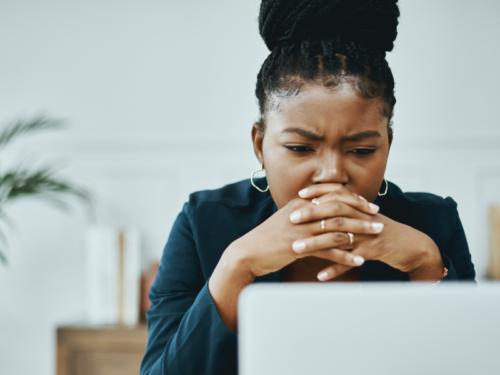
Table of Contents
How to Manage Panic Attacks With Meditation

Written By: Kera Passante, MS, LPC

Clinically Reviewed By: Dr. Don Gasparini
June 16, 2023
6 min.
Meditation activates the body’s relaxation response and calms the nervous system, which can help people manage panic attacks. Keep reading for a step-by-step guided meditation for panic attack management.
Learn more about our Clinical Review Process
Table of Contents
Guided meditation for panic attacks: a step-by-step mindfulness meditation
Here’s a simple step-by-step mindfulness meditation technique to use for managing panic attacks:
Find a comfortable position
Sit or lie down in a comfortable position in a quiet and peaceful environment. Close your eyes if it helps you focus.
Deep breathing
Begin by taking a few slow, deep breaths. Inhale deeply through your nose, feeling your stomach rise, and then exhale slowly through your mouth, letting go of any tension or stress with each breath. Throughout the meditation, maintain a steady and relaxed breathing pattern. If your mind starts to wander or if anxious thoughts arise, gently bring your attention back to your breath and the present moment.
Body scan
Bring your attention to your body and start scanning from head to toe, noticing any areas of tension or discomfort. As you identify any tension, consciously release it and allow that body part to relax.
Get grounded
Shift your focus to the present moment by engaging your senses. Notice the sensations of your body against the surface you’re sitting or lying on. Pay attention to the feeling of your feet on the ground, the temperature of the air, or any sounds you can hear.
Visualize a safe place
Imagine yourself in a calm and peaceful environment that makes you feel safe and secure. It could be a serene beach, a beautiful garden, or a cozy room. Picture the details of this place, including the colors, sounds, and smells. Engage your senses and allow yourself to feel the peace and tranquility of that environment.
Affirmations
Repeat positive affirmations to yourself, such as “I am safe,” “I am in control of my body and mind,” or “I can manage this panic attack.” Choose affirmations that resonate with you and provide a sense of reassurance.
Gradual return
When you feel ready, slowly bring your awareness back to your surroundings. Wiggle your fingers and toes, stretch your body gently, and open your eyes.

More than just weekly therapy – a healing community.
Personalized treatment for anxiety disorders from home.
How meditation can help with panic attacks
Meditation can make people feel more relaxed, less stressed out, and more self-aware—all of which can help manage panic attacks. During a panic attack, the body enters a state of heightened anxiety and arousal. Your heart might start racing, it may become hard to breathe, and you might not be able to think clearly. Meditation activates the relaxation response, calming the nervous system, lowering heart rate, and reducing muscle tension, leading to a sense of relaxation and calmness.
Meditation also cultivates mindfulness, allowing people to observe their thoughts and physical sensations without becoming overwhelmed by them. This increased self-awareness helps people recognize the early signs of a panic attack and intervene proactively. Regular meditation also improves emotional regulation, helps challenge negative thinking patterns, and lowers overall stress levels, reducing the frequency and intensity of panic attacks.
To fully harness these benefits, though, consistency is key. Try incorporating meditation gradually, even for five minutes per day, increasing the time as you become more comfortable with the practice. Finding what works best for you may take time, so feel free to adjust the meditation technique to suit your needs.
Although meditation is an important tool for managing the severity or frequency of panic attacks, it is not a substitute for professional help from a mental health provider. Whether you had a one-off panic attack or think you may have panic disorder—diagnosed by at least two panic attacks and one month of worrying about another panic attack—therapy is essential for managing your mental health.
Join the Charlie Health Library
Get mental health updates, research, insights, and resources directly to your inbox.
You can unsubscribe anytime.
Other tips for dealing with a panic attack
In addition to sitting down for a guided meditation, you can do other mindfulness techniques to help manage panic attacks. Many of these techniques incorporate principles of dialectical behavior therapy (DBT), a talk therapy that focuses on mindfulness and distress tolerance—skills that are particularly important in coping with panic attacks. Like meditation, these techniques supplement professional help for panic attacks; they do not replace it. Here are some tips for dealing with a panic attack when you feel one coming on:
Create a safe space
Designate a specific area in your home where you feel safe and comfortable. This could be a cozy corner with pillows and blankets or a room with soothing decorations. Having a designated safe space can provide a sense of security during a panic attack.
Practice self-soothing techniques
Engage in self-soothing activities that promote relaxation. Take a warm bath, listen to calming music, cuddle with a soft blanket or stuffed animal, or sip on a warm cup of herbal tea. Choose the relaxation technique that best suits you! These activities can help soothe your senses and reduce panic symptoms.
Try something cold
Applying cold stimuli, such as splashing cold water on your face, holding an ice pack, or placing a cold towel on the back of your neck, can help interrupt the escalating panic response and provide a sensory distraction from a panic attack. The cold sensation can help redirect your focus away from the panic symptoms and create a physiological response that counteracts the heightened arousal associated with panic.

Use grounding techniques
Engage your senses to ground yourself in the present moment. Look around the room and name five things you can see, four things you can touch, three things you can hear, two things you can smell, and one thing you can taste. This helps redirect your attention away from the panic and into the immediate environment.
Practice deep breathing
Focus on slow, deep breaths to regulate your breathing. Inhale deeply through your nose, hold for a few seconds, and exhale slowly through your mouth. Place one hand on your abdomen to feel the breaths and focus on the sensation of your breath.
Try a progressive muscle relaxation exercise
Tense and then relax each muscle group in your body. Start with your toes and work your way up to your head, consciously relaxing each muscle as you go. This technique helps release tension and promotes overall relaxation.
Reach out for support
If you feel comfortable, reach out to a trusted friend or family member via phone or video call. Simply talking to someone who understands and supports you can provide reassurance and a sense of connection during a panic attack.
Treatment for panic attacks
Panic attack treatment typically involves a combination of therapeutic approaches, primarily including cognitive behavioral therapy (CBT). CBT helps people identify and challenge the distorted thoughts and beliefs contributing to panic attacks. The goal is to understand the underlying reasons and mechanisms driving panic attack thought cycles, equipping people with the necessary tools to cope with panic attacks. By gaining insight into the triggers and responses associated with panic, people are more prepared to navigate and overcome them.
Depending on the severity of someone’s symptoms, a healthcare provider might recommend medications as a treatment for panic attacks. Medications such as selective serotonin reuptake inhibitors (SSRIs) or benzodiazepines can help manage symptoms associated with panic attacks, as well as co-occurring mental health conditions, such as anxiety disorders and mood disorders.
Lifestyle changes like regular exercise, stress management techniques, and healthy sleep habits can also be a part of panic attack treatment, alongside therapy and medication as needed. Since every person is different, it’s important to consult with a mental health professional who can provide a comprehensive assessment and develop a personalized treatment plan tailored to individual needs.
Meditation and mindfulness therapy for panic attacks at Charlie Health
Charlie Health is committed to creating an unparalleled, multi-pronged approach to care for teens and their families, incorporating yoga, mindfulness, and meditation techniques into treatment—including for patients with panic disorder or dealing with frequent panic attacks. If you think that you might benefit from an individualized mental health treatment plan, reach out to learn more today.




